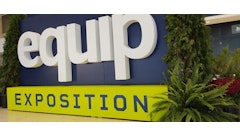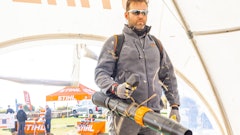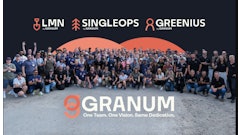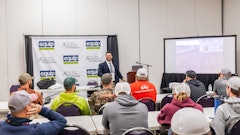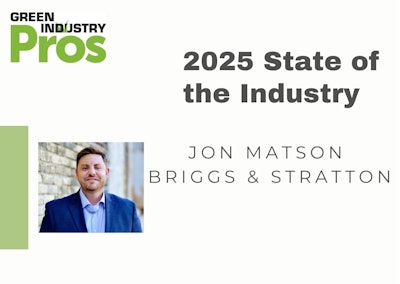
Jon Matson, vice president, sales and marketing, Briggs & Stratton, offers his take on the current state of the landscape industry, where the industry is headed and more.
Green Industry Pros: How would you describe the current state of the landscape industry?
Matson: It's still seeking a little bit of normalcy. We're finally coming out of all of the challenges that COVID threw at us. As homeowners are now starting to get really busy again and increasingly returning to the office, landscapers are benefitting as their clients have less time and more need for their services.
Additionally, we haven't had very good snow in the last two to three years, and that's a big revenue generator for landscapers, especially in the Midwest and the Northeast. That gives landscapers that seed money to purchase equipment early in a new year. So, I'm expecting really good snow this year, and I'm expecting landscapers to be in the market to replenish and repurchase products that might have gotten a little bit long in the tooth.
Broadly the commercial market seems to be stable. We're still facing some inflationary pressures, which affects retail financing. It affects what the dealers are holding in terms of inventory as well. As the season progressed through 2024, dealers wanted to see inventory taken down to a manageable level, and now, we're seeing dealers start to stock back at normal levels for 2025.
For manufacturers, I think supply chain challenges have evened out now, and most manufacturers have started to weather all of the economic forces. It's interesting because while there are some economic pressures, this industry is so weather dependent it's much more about weather for us. Trying to understand what the true demand after a COVID correction is where we are now, and my gut says that the new normal is potentially a more fluid and more agile position on inventory as we move on.
For all of us, landscapers, distributors, dealers and manufacturers, we're seeking normalcy is what I would start with and end with.
Green Industry Pros: What trends have you noticed within the past year or so?
Matson: We're still seeing labor shortage trends as a headwind for dealerships and landscapers, which is driving a need for more efficient and more productive equipment.
We’ve seen a high desire for products and features that offer less maintenance and less downtime. In the past, a landscaper may have had the ability to flex employees that would have been able to do maintenance in the shop at the at the end of the week or over the weekend. Now it's all hands on deck to just perform for the clients that they have on the books.
As far as electrification, I think that there is a time and a place for electrification, but we're also seeing it as a challenge because of the increased cost of an electrified product. So, we're seeing a little bit of a spike in gas-powered equipment that lets us know that gas is here for a long time to come.
Finally, another trend I’m seeing is private equity firms getting active in the industry leading to some consolidation. The PE firms are grabbing a lot of these smaller landscape companies, which the firms are then aggregating for scale.
I think there's more to come as dealers are aging and as we deal with this shortage of people wanting to get into the dealership space. It's creating an opportunity for PE firms or even larger dealers to consume smaller dealers and scale for efficiency.
Green Industry Pros: What challenges are you hearing from landscape customers, and how are they contending with those challenges?
Matson: Labor is the big one. Dealerships are trying to find technicians, and landscapers are trying to find people who will work from sunup to sundown.
And, it's seasonal work, which is why snow is important. If you can keep the totality of your workforce intact for the entire year, that provides more continuity for that business in the in the in the long term.
It’s about skilled labor as well. I'm seeing professional cutters branching out to additional higher-value revenue opportunities. They may have started just cutting grass, and now they’re pursuing landscape installs or offering sprayer-spreader services on the fertilizer application side of the business where the margins are really good. Those opportunities take the right skilled labor, education and certification.
Green Industry Pros: What are your expectations for 2025?
Matson: The role of the dealer and the importance of the right dealer strategies will continue to grow. They provide a service to landscape professionals that retail doesn't provide, and it's those tailored experiences that help contractors minimize downtime. Dealers understand the urgency of the landscaper coming in with equipment that's down and needing to get that equipment back on the trailer and operating.
So, we're seeing dealers look at maintenance programs to ensure that downtime is mitigated. There will also be an increased need for leasing and traditional retail financing; dealers offer those types of tailored solutions to landscape professionals. As a manufacturer, we're focusing a lot on our dealers, and I see that continuing, and even increasing, in 2025.

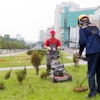
![Doosan Bobcat Wacker Neuson Stack 2ec Js Pb V6e[1]](https://img.greenindustrypros.com/mindful/acbm/workspaces/default/uploads/2025/12/doosan-bobcat-wacker-neuson-stack2ecjspbv6e1.CPyyz8ubHn.png?auto=format%2Ccompress&bg=fff&fill-color=fff&fit=fill&h=100&q=70&w=100)


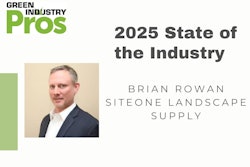
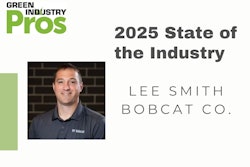
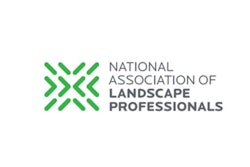
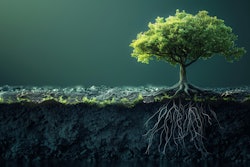

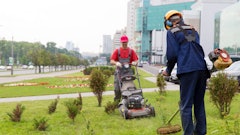
![Doosan Bobcat Wacker Neuson Stack 2ec Js Pb V6e[1]](https://img.greenindustrypros.com/mindful/acbm/workspaces/default/uploads/2025/12/doosan-bobcat-wacker-neuson-stack2ecjspbv6e1.CPyyz8ubHn.png?ar=16%3A9&auto=format%2Ccompress&bg=fff&fill-color=fff&fit=fill&h=135&q=70&w=240)

